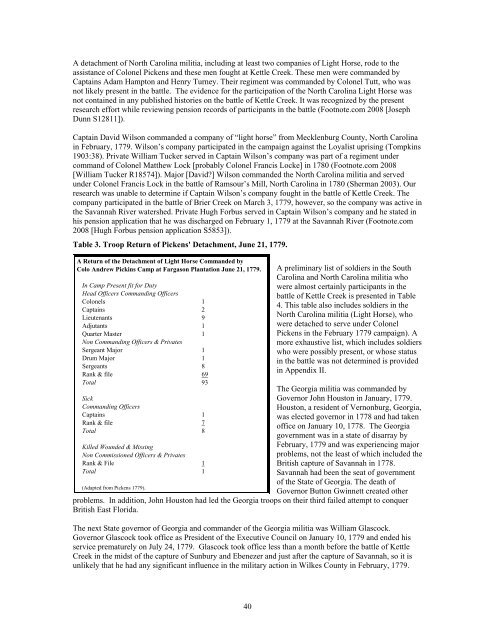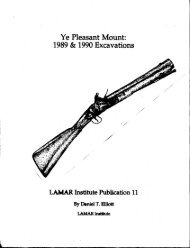Stirring Up a Hornet's Nest: - UGA Laboratory of Archaeology ...
Stirring Up a Hornet's Nest: - UGA Laboratory of Archaeology ...
Stirring Up a Hornet's Nest: - UGA Laboratory of Archaeology ...
Create successful ePaper yourself
Turn your PDF publications into a flip-book with our unique Google optimized e-Paper software.
A detachment <strong>of</strong> North Carolina militia, including at least two companies <strong>of</strong> Light Horse, rode to the<br />
assistance <strong>of</strong> Colonel Pickens and these men fought at Kettle Creek. These men were commanded by<br />
Captains Adam Hampton and Henry Turney. Their regiment was commanded by Colonel Tutt, who was<br />
not likely present in the battle. The evidence for the participation <strong>of</strong> the North Carolina Light Horse was<br />
not contained in any published histories on the battle <strong>of</strong> Kettle Creek. It was recognized by the present<br />
research effort while reviewing pension records <strong>of</strong> participants in the battle (Footnote.com 2008 [Joseph<br />
Dunn S12811]).<br />
Captain David Wilson commanded a company <strong>of</strong> “light horse” from Mecklenburg County, North Carolina<br />
in February, 1779. Wilson’s company participated in the campaign against the Loyalist uprising (Tompkins<br />
1903:38). Private William Tucker served in Captain Wilson’s company was part <strong>of</strong> a regiment under<br />
command <strong>of</strong> Colonel Matthew Lock [probably Colonel Francis Locke] in 1780 (Footnote.com 2008<br />
[William Tucker R18574]). Major [David?] Wilson commanded the North Carolina militia and served<br />
under Colonel Francis Lock in the battle <strong>of</strong> Ramsour’s Mill, North Carolina in 1780 (Sherman 2003). Our<br />
research was unable to determine if Captain Wilson’s company fought in the battle <strong>of</strong> Kettle Creek. The<br />
company participated in the battle <strong>of</strong> Brier Creek on March 3, 1779, however, so the company was active in<br />
the Savannah River watershed. Private Hugh Forbus served in Captain Wilson’s company and he stated in<br />
his pension application that he was discharged on February 1, 1779 at the Savannah River (Footnote.com<br />
2008 [Hugh Forbus pension application S5853]).<br />
Table 3. Troop Return <strong>of</strong> Pickens' Detachment, June 21, 1779.<br />
A Return <strong>of</strong> the Detachment <strong>of</strong> Light Horse Commanded by<br />
Colo Andrew Pickins Camp at Fargason Plantation June 21, 1779.<br />
In Camp Present fit for Duty<br />
Head Officers Commanding Officers<br />
Colonels 1<br />
Captains 2<br />
Lieutenants 9<br />
Adjutants 1<br />
Quarter Master 1<br />
Non Commanding Officers & Privates<br />
Sergeant Major 1<br />
Drum Major 1<br />
Sergeants 8<br />
Rank & file 69<br />
Total 93<br />
Sick<br />
Commanding Officers<br />
Captains 1<br />
Rank & file 7<br />
Total 8<br />
Killed Wounded & Missing<br />
Non Commissioned Officers & Privates<br />
Rank & File 1<br />
Total 1<br />
(Adapted from Pickens 1779).<br />
40<br />
A preliminary list <strong>of</strong> soldiers in the South<br />
Carolina and North Carolina militia who<br />
were almost certainly participants in the<br />
battle <strong>of</strong> Kettle Creek is presented in Table<br />
4. This table also includes soldiers in the<br />
North Carolina militia (Light Horse), who<br />
were detached to serve under Colonel<br />
Pickens in the February 1779 campaign). A<br />
more exhaustive list, which includes soldiers<br />
who were possibly present, or whose status<br />
in the battle was not determined is provided<br />
in Appendix II.<br />
The Georgia militia was commanded by<br />
Governor John Houston in January, 1779.<br />
Houston, a resident <strong>of</strong> Vernonburg, Georgia,<br />
was elected governor in 1778 and had taken<br />
<strong>of</strong>fice on January 10, 1778. The Georgia<br />
government was in a state <strong>of</strong> disarray by<br />
February, 1779 and was experiencing major<br />
problems, not the least <strong>of</strong> which included the<br />
British capture <strong>of</strong> Savannah in 1778.<br />
Savannah had been the seat <strong>of</strong> government<br />
<strong>of</strong> the State <strong>of</strong> Georgia. The death <strong>of</strong><br />
Governor Button Gwinnett created other<br />
problems. In addition, John Houston had led the Georgia troops on their third failed attempt to conquer<br />
British East Florida.<br />
The next State governor <strong>of</strong> Georgia and commander <strong>of</strong> the Georgia militia was William Glascock.<br />
Governor Glascock took <strong>of</strong>fice as President <strong>of</strong> the Executive Council on January 10, 1779 and ended his<br />
service prematurely on July 24, 1779. Glascock took <strong>of</strong>fice less than a month before the battle <strong>of</strong> Kettle<br />
Creek in the midst <strong>of</strong> the capture <strong>of</strong> Sunbury and Ebenezer and just after the capture <strong>of</strong> Savannah, so it is<br />
unlikely that he had any significant influence in the military action in Wilkes County in February, 1779.










